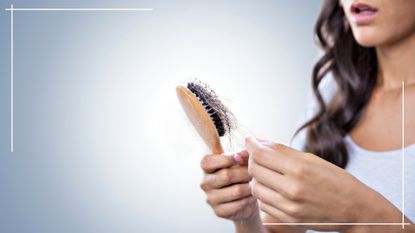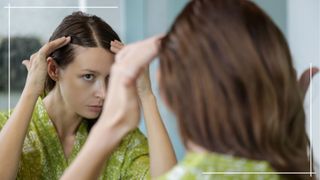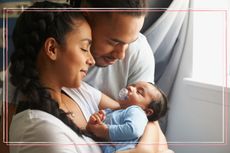Alopecia - what is it, what causes it and what treatments are there
If you're worried about alopecia, make sure you read our guide...


Alopecia is a wider term for all kinds of hair loss. With alopecia areata - autoimmune condition - as the most common.
And while it's not fully understood why some people develop the NHS estimates women are most likely to experience hair loss after menopause, or even early menopause, at an age average of 52. With half of men experiencing some form of hair loss by the time they reach 50. For some people, they will lose a lot of hair and be left wondering how to speed up hair growth. And many will experience a type of alopecia, meaning the complete or partial absence of hair where it is normally meant to grow.
And it's not just the hair on our head that can be affected, Amy Johnson from charity Alopecia UK tells us; "many people who suffer from alopecia will lose eyebrows, eyelashes and even arm or leg hair, too."
Alopecia
What is alopecia?
Alopecia is the medical term for bald. While there are many variants, Alopecia Areata is one of the most common causes of hair loss or thinning, apart from heredity hair loss. It's estimated, by The Belgravia Centre, that it affects one person in every 100 and genetics play a role in one in five cases. Those suffering from Alopecia Areata often experience sudden, dramatic and recurring hair loss and it can affect men, women and children.
There are nine types of alopecia;
- Alopecia areata - an autoimmune condition which causes hair to fall out in round or oval patches.
- Androgentic alopecia - Male or female pattern baldness. With hair usually becoming thinner all over the head.
- Central Centrifugal Cicatricial alopecia - A condition causing permanent hair loss from destroyed hair follicles, starting int centre of the scalp spreading outwards.
- Chemotherapy induced alopecia - Hair falls out due to chemotherapeutic drugs.
- Frontal Fibrosing Alopeciameans - scarring hair loss that affects the frontal region of the scalp
- Lichen Planopilaris - scarring hair loss that affects the sides front and lower scalp.
- Telogen Effluviumpatchy - when hair follicles 'rest; and stop growing before falling out.
- Traction Alopecia - caused by strain on the hair follicles, often from tight hairstyles.
- Trichotillomania - a condition that leads to an overwhelming urge to pull out hair.
What are alopecia symptoms?
There are many and they vary;
- Tingling sensation in the scalp
- Loss of hair in patches
- Gray and white hairs often remain where you have hair loss
- Hair starts to regrow on its own where it fell out
- Hair loss occurs during a colder month of the year
- Loss of eyelashes
- Brittle nails
- Red nails
As with the causes, there are hugely varying symptoms depending on the type of alopecia. However, The Belgravia Centre in London shows male pattern baldness and female pattern hair loss as the most common conditions. In women this usually becomes apparent with hair thinning across the crown of the head. The hairline often isn't affected, outside of the receding we all experience as we age.
GoodtoKnow Newsletter
Parenting advice, hot topics, best buys and family finance tips delivered straight to your inbox.
For less common kinds of alopecia, signs and symptoms range from bald patches and hair thinning to scaly and itchy skin.
What causes alopecia?
There are many causes of alopecia. They’re as varying as the different types of alopecia out there. For instance, for many men who experience hair thinning - it's usually because of hereditary genetics. If hair loss isn't hereditary, causes range from emotional and physical stress to severe dieting and strong medication, depending on the type of alopecia.
Amy tells us why it's important to change people's perceptions of the causes of alopecia. She explains, "The most common misconception about hair loss of any kind is that it's simply caused by stress. It's definitely not as simple as that.
"'In cases of alopecia areata, often labelled as "stress alopecia" by the media and some doctors, some individuals can link their first bald patch to a stressful event, but some cannot. Alopecia Areata can strike at any age and some have it occur at the time in their lives when they are most content."
She adds: "When 'stress' is discussed, we need to recognise that stress can be physical stresses on the body and not just emotional stress. Some believe their alopecia is triggered by infection, physical pain, hormonal imbalances etc. There needs to be more research into the causes and triggers, before we can be satisfied that we fully understand the cause of the condition."

Is there alopecia treatment?
There are treatments. Though no completely successful treatments are currently available for Alopecia Areata at the moment, but many people will see their hair grow back naturally after some time. For both female and male pattern hair loss the treatment options are limited, and even those offered don't have a hugely high success rate.
Minoxidil lotion - is currently the most widely available treatment option for men and women who suffer from alopecia but it needs to be used for several months before any results may be seen, and even then the NHS estimate it will only help hair regrowth in one in every four women. Here are some of the most common treatments:
Topical ('rub-on') steroid - Steroid cream, gel, etc, may help hair re-growth, but does not work as well as steroid injections. It may be worth a try if you have bald patches that are not suitable for steroid injections, or if you are waiting to see a specialist to have steroid injections. If re-growth occurs it takes 3-6 months. There is no point continuing with this treatment if no re-growth occurs after six months.
Minoxidil solution - This is rubbed into the bald patches and has been shown to promote hair re-growth in some cases. This is the same treatment that is used for the common male pattern baldness. It is not known how it works. The success rate is not high but may be worth a try. In particular, if you have more extensive bald patches that are not suitable for steroid injections, or if you are waiting to see a specialist for steroid injections.
Minoxidil is not available on the NHS. You need a private prescription and have to pay the full cost of the product, which makes it expensive. If it works, it usually takes 2-3 months of treatment for an initial response, and one year for a maximum response. There is no point continuing with this treatment if there is no improvement after one year.
Some people feel that combining a topical steroid with minoxidil gives a higher chance of hair re-growth than either treatment alone. However, there is little research evidence to prove this.
Steroid injections - Injections of steroid into the bald patches of the scalp suppresses the local immune reaction that occurs in alopecia areata. This can then allow the hair follicles to function normally again and for hair to re-grow. This treatment may be an option for one or more small to medium sized bald patches. Steroid injections are thought to be the most effective treatment for patches of alopecia areata that are not too big. However, they do not work in every case.
This treatment is usually only done by a skin specialist and so you will usually need to be referred to hospital for it. Several injections (about 1 cm apart) are usually given at each session of treatment but the number is often limited by pain. Therefore, large bald areas are not suitable for steroid injections. Initial re-growth takes 1-2 months and injections are repeated every 4-6 weeks.
On the subject of treatment Amy talks about the variations in people's reactions to different types. She tells us; "Unfortunately there are no treatments guaranteed to work and what shows some results for one person may not for another. Also treatment options which are offered can vary considerably between dermatologists."
Is alopecia genetic?
The inheritance pattern of alopecia areata is unclear, because multiple genetic and environmental factors appear to be involved, according to a paper at the National Library of medicine.
Overall, the risk of developing the condition is greater for first-degree relatives (such as siblings or children) of affected individuals than it is in the general population. Though, according to research by Royal Infirmary of Edinburgh about 20% of people with alopecia areata have a family history.
Is alopecia curable?
No, alopecia cannot be cured. According to the British Association of Dermatologists, depending on the extent of hair loss there is a good chance that, for 4 out of 5 affected people, complete regrowth will occur within 1 year without treatment. Though, there may be episodes of hair loss in the future. And, the chances of regrowth are not so good in young children.
Does alopecia come with any other health complications?
Besides the physical symptoms of hair loss and the emotional issues surrounding changing appearances Amy also says, 'As well as the psychological impact of alopecia, there are also some physical impacts. A lack of nasal hair can result in a dripping-tap nose – a continued irritation to many a person with alopecia and a lack of eyelashes can result in irritation to the eyes, as lashes provide a barrier to grit getting into the eyes.'
How to cope with alopecia
Many people who experience alopecia will naturally feel anxious about their changing appearance. Amy says: "Coming to terms with alopecia is about finding a way to "manage" the condition. Many turn to wigs, hats and scarves to cover their hair loss. Some are happier to embrace their baldness. Overall, remember that people can still look great with hair loss. You need to find what works for you.
"Our best advice is to seek out others with alopecia for support. You can feel isolated with alopecia but there are plenty of people who know how you feel. Speak to others and you will find a great source of emotional support and practical advice. Alopecia UK has a number of local support groups listed in its website as well as an active Facebook group and online forum, too.'
She adds: 'Some people really struggle to come to terms with their diagnosis and some never do. It can depend on the personality of the individual and the support network around them'.
For more information and support:
Tel: 0800 101 7025 | E-mail: info@alopecia.org.uk
National Alopecia Areata Foundation
British Association of Skin Camouflage (NHS and private practice)
Tel: 01254 703 107 | Email: info@skin-camouflage.net
If you're experiencing hair loss or alopecia, and are worried, visit the NHS website or see your doctor who will be able to advise further.
Video of the week:

Stephanie Lowe is Family Editor at GoodToKnow covering all things parenting, pregnancy and more. She has over 13 years' experience as a digital journalist with a wealth of knowledge and experience when it comes to all things family and lifestyle. Stephanie lives in Kent with her husband and son, Ted. Just keeping on top of school emails/fund raisers/non-uniform days/packed lunches is her second full time job.
-
 I tested the Lakeland Dual Basket air fryer and it made midweek family cooking a breeze
I tested the Lakeland Dual Basket air fryer and it made midweek family cooking a breezeYou can’t go wrong with the dual basket air fryer by Lakeland complete with easy-view windows to ensure burnt food is a thing of the past…
By Jessica Dady Published
-
 Reframing one simple habit could get your sex life back on track after having a baby, new research shows
Reframing one simple habit could get your sex life back on track after having a baby, new research showsMany parents struggle to get their sex life back on track after having a baby, but new research has shown how one simple habit could make all the difference.
By Ellie Hutchings Published